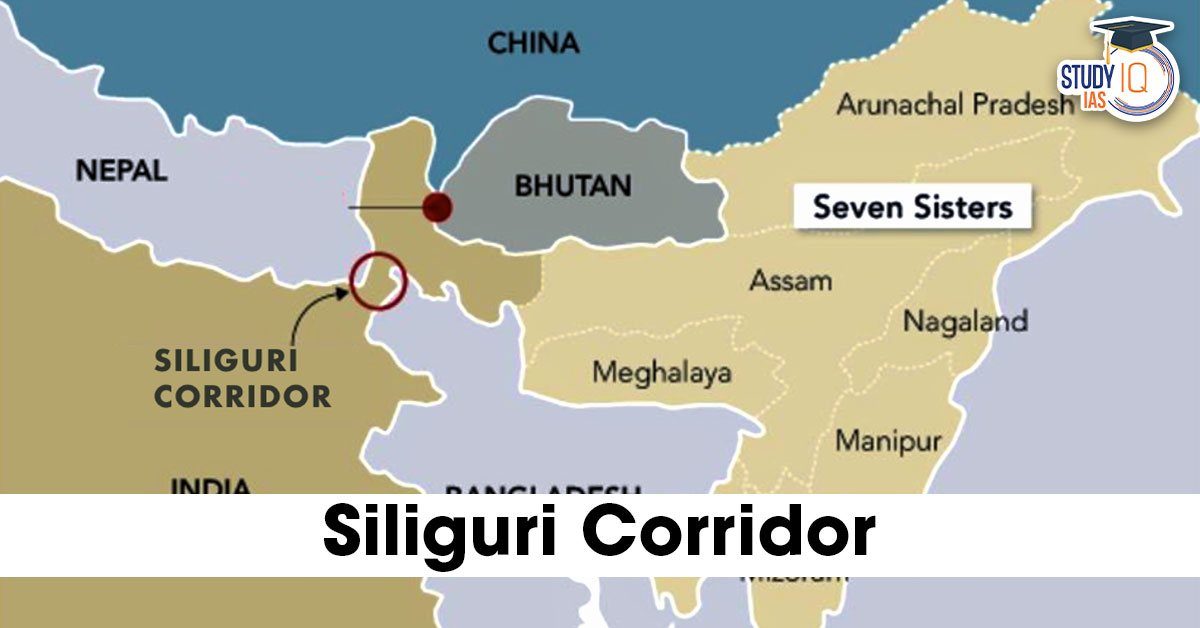Table of Contents
The Indian Army recently conducted a major exercise named Teesta Prahar near the Siliguri Corridor, often called the Chicken Neck of India, highlighting its commitment to safeguarding this vital passage. Over three days at the Teesta field firing range, forces tested their combat readiness on complex riverine terrain, involving infantry, artillery, armoured corps, mechanised infantry, para-special forces, army aviation, engineers, and signals.
The exercise showcased joint force integration, modern weaponry, and adaptive manoeuvres, reflecting the Indian Army’s focus on modernisation and swift operational response. This comes at a time when tensions near the corridor have escalated due to China’s growing presence in neighbouring Bangladesh and its deepening defence ties in the region.
What is the Siliguri Corridor and Why is it Called the “Chicken Neck”?
The Siliguri Corridor is a narrow stretch of land roughly 20 to 25 kilometers wide that connects India’s northeastern states to the rest of the country. It is flanked by Nepal to the west, Bangladesh to the south, Bhutan to the north, and China’s Tibet Autonomous Region, just about 200 km to the north. This corridor is crucial because:
-
It is India’s only land link to the entire Northeastern region.
-
More than 45 million people and numerous economic activities rely on this corridor.
-
Its vulnerability is underscored by its narrowness, making it susceptible to blockade or invasion — hence the nickname “Chicken Neck”.
Teesta Prahar Exercise
Teesta Prahar was a comprehensive integrated field firing exercise carried out by the Indian Army at the Teesta Field Firing Range in West Bengal during the second week of May 2025 (mainly on May 8th and 9th, 2025).
Objective
The Teesta Prahar exercise was intended to demonstrate and authenticate the operational preparedness and coordination between different combat and support weapons of the Indian Army in riverine terrain. It is also intended to check the Army’s proficiency in undertaking rapid and effective operations in different terrains and adverse weather conditions.
Location
The Teesta Field Firing Range is strategically important because of its location near the Siliguri Corridor, popularly referred to as the “Chicken’s Neck,” a crucial narrow strip of land linking India’s northeastern states to the rest of India.
Participants
The Teesta Prahar exercise witnessed active participation by main combat and support troops, including:
- Infantry
- Artillery
- Armoured Corps
- Mechanised Infantry
- Para Special Forces
- Army Aviation
- Engineers
- Signals
Strategic Significance of the Siliguri Corridor
-
Geopolitical Gateway: Connects the resource-rich Northeast to the Indian mainland. Losing control would isolate the region.
-
Border Security Hotspot: Proximity to China’s sensitive border areas and Bangladesh’s territory means any military activity here has outsized implications.
-
Economic and Cultural Link: The corridor supports trade routes and cultural exchanges with neighboring countries and acts as a vital transit hub.
-
Military Deployment: Presence of strategic army units like the Trishakti Corps, headquartered near Siliguri, and air bases like Hasimara with Rafale squadrons, emphasize India’s focus on defending this region.
Recent Developments: Is China Breaking the Chicken Neck of India?
Recent geopolitical events have raised concerns about China’s intentions in the Siliguri corridor:
-
China’s Involvement in Bangladesh’s Air Base at Lalmonirhat: Located barely 20 km from the Siliguri corridor, the proposed air base project with Chinese assistance potentially allows Beijing to extend its military footprint close to Indian territory.
-
Deepening China-Bangladesh Military Ties: China has increased arms supplies and infrastructure support to Bangladesh, raising fears that the Lalmonirhat air base might be used for monitoring Indian troop movements or as an intelligence hub.
-
Bangladesh’s Interim Government Shift: The fall of Sheikh Hasina’s pro-India government and the rise of a pro-China interim regime under Muhammad Yunus, who has repeatedly referred to Northeast India and the Chicken Neck, adds political uncertainty.
Why India is on High Alert
India’s military has responded proactively:
-
Conducting multiple large-scale exercises in and around the Siliguri corridor — including Teesta Prahar, Devil’s Strike, and SarvShakti — focusing on joint force coordination, riverine and mechanized operations, and integrating unmanned systems.
-
Maintaining a strong defence presence with Rafale fighter jets at Hasimara Air Base and Trishakti Corps poised for rapid deployment.
-
Enhanced intelligence monitoring on foreign developments in Bangladesh, including surveillance of the proposed air base.
Challenges Ahead: Securing the Chicken Neck
India faces several challenges:
-
Geopolitical Pressure: China’s Belt and Road Initiative and strategic outreach in South Asia aim to encircle India, making Siliguri a prime vulnerability.
-
Diplomatic Balancing: India must engage diplomatically with Bangladesh to ensure its sovereignty is not compromised while countering external influences.
-
Infrastructure and Connectivity: Improving alternative routes (like the Kaladan Multi-Modal Transit Transport Project) to reduce over-dependence on the corridor.
-
Local Stability: Managing insurgency and cross-border illegal activities to maintain peace in the Northeast.
Conclusion
The Siliguri Corridor is undeniably one of India’s most sensitive strategic points. The Teesta Prahar exercise and other military preparations underscore the Indian Army’s resolve to defend this narrow gateway connecting the northeast with the rest of the country.
While China’s growing presence in Bangladesh and its military ambitions raise legitimate security concerns, India’s robust defense posture, enhanced diplomatic efforts, and infrastructure projects aim to keep the Chicken Neck intact.
Vigilance, modernization, and proactive diplomacy will be key to ensuring that India’s strategic lifeline remains secure against evolving geopolitical challenges.


 UN ESCAP Asia-Pacific Disaster Report 20...
UN ESCAP Asia-Pacific Disaster Report 20...
 Rare Hawfinch Sighting in Corbett Nation...
Rare Hawfinch Sighting in Corbett Nation...
 Bnei Menashe Community : The Lost Tribe ...
Bnei Menashe Community : The Lost Tribe ...

























